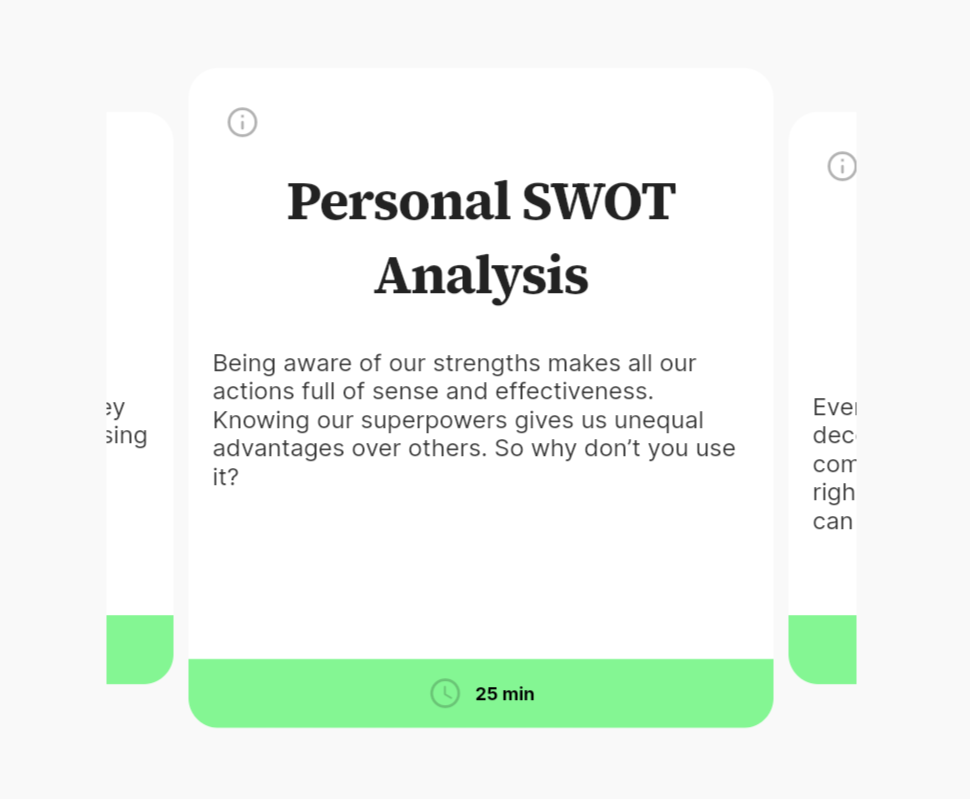The SWOT analysis defines your strengths, weaknesses, opportunities, and threats. SWOT helps you understand your capabilities and areas for development. And uncover your superpowers! On top of that, you will be prepared for obstacles. Identifying threats lets you strategize solutions in advance and cope with a clearer vision.
This technique is valuable at any career stage, whether just starting, looking to advance, or navigating a career transition. Drawing SWOT may take time in addition to saving notes in an appropriate place, but you can simplify the process by practicing on the Amy platform.

What do you need to do for the SWOT analysis?
When taking the exercise on the platform, consider strengths and weaknesses as internal areas. Opportunities and threats belong more to external factors.
- For strengths, you will be asked to recall at least three situations you were successful at, what motivated you, what made you proud of yourself, and what was the best part of this experience. For weaknesses—in what areas do you feel you lack expertise?
- Opportunities shed light on what options are open to you now. How can you turn your strength into opportunities, given your life context? Threats are about the points that may affect your role, job, or industry. And any personal challenges that may slow your progress.
How can you benefit from SWOT?
As a result of the SWOT analysis, you have:
- Your strengths and opportunities mapped
- Steps you can take to address threats
- Action items to progress in achieving your career goals
- Overview of your values
For a detailed analysis of values, the platform correspondingly offers two exercises, Your Life Values and Your Work Values, to identify what truly matters to you in your personal and professional life.
SWOT analysis example
The example of Emma, a UI/UX Designer, might support you in your SWOT.
Strengths
What was the situation in which I was successful and proud of myself?
“In a limited amount of time, I delivered a user-friendly design mockup to a demanding client. They came back with great reviews and recommended me to the company they collaborate with.”
What are my strengths?
- Vast experience in product design, particularly in big tech companies, which enhances credibility and expertise.
- Consistent positive feedback from clients and customers, indicating a solid ability to create user-friendly designs that simplify their experiences, especially in the FinTech sector.
- Demonstrated success through proven use cases, which can be showcased in my portfolio to attract new clients or employers.
- High level of dedication and commitment to my work, resulting in high-quality outcomes.
Weaknesses
In what areas do I lack expertise? What tasks do I find challenging?
“I aim to improve at trending design and AI technologies but lack effort for learning activities. I sacrifice all my time for projects, and I cannot say “no” to them because of the many tasks on my plate already.”
What are my weaknesses?
- Struggle with assertiveness, which may affect communication and collaboration with team members or clients.
- Tendency to overwork and prioritize responsibilities and reputation over personal well-being, leading to potential burnout.
- Difficulty tolerating criticism, which can impact professional growth and feedback acknowledgment.
- Preference for stability and reluctance to take risks, making it challenging to transition to new roles or environments.
Opportunities
What opportunities can you take advantage of?
- Exploring freelance opportunities could provide flexibility and improve work-life balance while leveraging my extensive experience.
- Moving to a smaller company with fewer responsibilities may reduce stress and provide a supportive environment for growth.
- Investing time in developing assertiveness and coping strategies for criticism could enhance interpersonal relationships and professional growth.
- Engaging with other professionals in the UX/UI field could open doors to new opportunities and collaborations.
How can you connect your strengths and opportunities?
“My extensive background in design will make me a preferred candidate in the job market, particularly for smaller companies needing self-management and freelance clients seeking a trustworthy collaborator.”
Threats
What external and personal factors could pose threats to my career path?
- Overworking and sacrificing personal life for career responsibilities may lead to burnout, impacting performance and overall well-being.
- Changes in the job market or industry standards may require adapting to new skills or roles, which could be challenging, given my preference for stability.
- Being inflexible about career changes might prevent me from adapting to new job market trends and opportunities.
- Increased competition in the UX/UI design field, especially with the rise of freelance platforms and remote work, may make it harder to secure desirable positions.
How can I address the threads with three small steps today?
- I can write down my 5-10 work achievements to boost my confidence and add those items to my CV.
- This week, I can practice saying “no” to set boundaries without feeling guilty. For example, if my colleague asks for help with something I can’t take on, I will politely decline and explain why (because I am extremely busy with three other projects).
- I can talk to a career coach to figure out the reasons and patterns for my poor work-life balance and start following a smooth approach to enhance it.
This SWOT analysis highlights strengths in experience while addressing areas for improvement, such as assertiveness and work-life balance. By taking opportunities like freelancing and skill development, Emma can navigate the threats of burnout and competition while progressing in her career.
Take a step forward for your career plan
Identify your unique skills, recognize areas for improvement, expand your reach, and prepare for challenges—it’s all about SWOT, and you can nail it with a career self-coaching exercise. The analysis will then serve as a trustworthy groundwork for a career plan or roadmap we will discuss in later articles.
